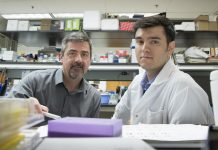February 2014 - Patients with diabetes are at increased risk of microvascular complications, which develop when the body's small blood vessels become diseased. One of the most common problems results when wounds fail to heal properly, which can lead to ulcers, chronic infections, and in the most serious cases, limb amputations.
Now investigators from Beth Israel Deaconess Medical Center (BIDMC) have discovered that a molecule called PGC-1alpha -- which has previously been shown to spur the growth of blood vessels in muscle -- has the opposite effect in the endothelial cells of patients with diabetes, impairing blood vessel growth and leading to dangerous vascular complications.
Reported in the journal Cell Metabolism, the new findings not only help explain the molecular mechanisms underlying microvascular disease in diabetes patients, they also suggest that because PGC-1alpha has opposing effects in different cell types, its role as a potential new therapeutic target should be pursued with caution.
"Diabetes is the number one cause of amputations in the U.S.," explains senior author Zoltan Arany, MD, PhD, an investigator in BIDMC's CardioVascular Institute and Associate Professor of Medicine at Harvard Medical School (HMS). "While it's been believed that high levels of glucose were somehow to blame for the inability of chronic ulcers and infections to properly heal in these patients, it wasn't completely understood how this was happening."
With this new research, says Arany, it is apparent that high levels of blood glucose -- the hallmark of diabetes -- induces high levels of the PGC-1 alpha molecule in the endothelial cells lining the blood vessels. This, in turn, prevents endothelial cells from properly functioning, inhibiting blood vessel growth.
Continue Reading Below ↓↓↓
Arany's laboratory has studied PGC-1 alpha for more than a decade. Among the molecule's diverse roles, he has discovered that when body parts are jeopardized by poor circulation, PGC-1 alpha senses dangerously low levels of oxygen and nutrients in muscle cells and, in response, spurs the growth of new blood vessels, a process known as angiogenesis.
"In muscle cells, we've found that PGC-1alpha is pro-metabolic, and a critical regulator of angiogenesis," he explains. "But the key cells responsible for carrying out angiogenesis are the endothelial cells that line the blood vessels. We, therefore, decided to investigate the role of endothelial PGC-1 alpha in diabetes."
Through a series of cell culture experiments, as well as experiments in endothelial-specific genetic mouse models, the authors showed that PGC-1alpha in endothelial cells is induced by diabetes, which strongly inhibits endothelial migration and angiogenesis, and leads to vascular dysfunction.
"These findings were definitely surprising, because the effects of PGC-1 alpha in endothelial cells are the opposite of its effects in muscle cells," notes Arany. "In muscle cells, it's pro-metabolic and will call forth more blood vessels and come to the rescue when an injury or artery blockage leaves normal tissue starved for blood." But, he adds, it's now clear that this molecule behaves quite differently in endothelial cells, preventing blood vessel growth in diabetes patients and preventing wounds from healing.
"This isn't just interesting and paradoxical, it's a potentially very important finding that reminds us that the same molecule can do different things in different cell types," adds Arany, explaining that if you make a medication that targets a particular pathway, it could potentially have positive effects in one tissue or cell type, but negative effects in another.
"PGC-1 alpha is generally considered a 'good' molecule in terms of improving health when it's activated," he adds. "But as these findings show, this isn't the case in the vasculature – activation leads to potentially serious problems. This striking observation stresses the need for caution, for example, when designing drugs aimed at PGC-1 alpha."
Study co-authors include co-first authors Naoki Sawada (currently at the University of Chicago) and Aihua Jiang of BIDMC; Fumihiko Takizawa and Yoshihiro Ogawa of Tokyo Medical and Dental University, Adeel Safdar and Laura Benjamin of BIDMC; Andre Manika, Yevgenia Tesmenitsky, Hermann Kalwa, Juliano L. Sartoretto, Thomas Michel and Kevin Croce of Brigham and Women's Hospital; Kyu-Tae Kang of Duksung Women's University; Joyce Bischoff of Boston Children's Hospital; Hirotaka Watada of Juntendo University Graduate School of Medicine; Yasutomi Higashikuni of The University of Tokyo Graduate School of Medicine; Chase W. Kessinger and Farouc A. Jaffer of Massachusetts General Hospital; Masataka Sata of The University of Tokushima Graduate School; and Rica Tanaka of Jutendo University Graduate School of Medicine.
This study was supported by grants from the National Heart Lung Blood Institute, the National Institute of General Medicine Sciences, the American Heart Association, the American Diabetes Association, and the Ellison Medical Foundation, as well as the Takeda Science Foundation; Japan Vascular Disease Foundation; Astra Zeneca Research Grant and Suzuken Memorial Foundation.
Source: Beth Israel Deaconess Medical Center










